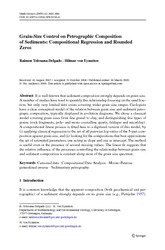Grain-Size Control on Petrographic Composition of Sediments: Compositional Regression and Rounded Zeros
Tolosana-Delgado, Raimon
Eynatten, Hilmar
41, 8: 869 - 886
DOI: https://doi.org/10.1007/s11004-009-9216-6
Persistent URL: http://resolver.sub.uni-goettingen.de/purl?gldocs-11858/7104
Persistent URL: http://resolver.sub.uni-goettingen.de/purl?gldocs-11858/7104
Tolosana-Delgado, Raimon; Eynatten, Hilmar, 2009: Grain-Size Control on Petrographic Composition of Sediments: Compositional Regression and Rounded Zeros. In: Tolosana-Delgado, Raimon; Eynatten, Hilmar (2009): Grain-Size Control on Petrographic Composition of Sediments: Compositional Regression and Rounded Zeros - Mathematical Geosciences; Vol. 41, Nr. 8, p. 869-886. Springer-Verlag, DOI: 10.1007/s11004-009-9216-6.
 |
Dokument öffnen: |
It is well-known that sediment composition strongly depends on grain size. A number of studies have tried to quantify this relationship focusing on the sand fraction, but only very limited data exists covering wider grain size ranges. Geologists have a clear conceptual model of the relation between grain size and sediment petrograpic composition, typically displayed in evolution diagrams. We chose a classical model covering grain sizes from fine gravel to clay, and distinguishing five types of grains (rock fragments, poly- and mono crystalline quartz, feldspar and mica/clay). A compositional linear process is fitted here to a digitized version of this model, by (i) applying classical regression to the set of all pairwise log-ratios of the 5-part composition against grain size, and (ii) looking for the compositions that best approximate the set of estimated parameters, one acting as slope and one as intercept. The method is useful even in the presence of several missing values. The linear fit suggests that the relative influence of the processes controlling the relationship between grain size and sediment composition is constant along most of the grain size spectrum.
Statistik:
ZugriffsstatistikSammlung:
- Geologie [933]

